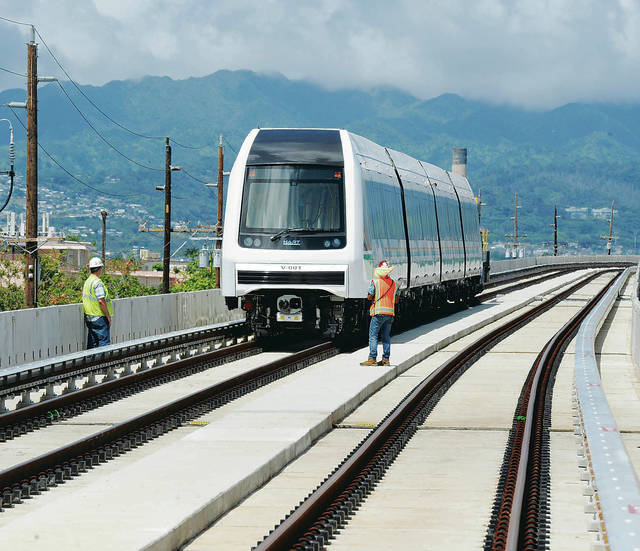The contractor tasked with building the rail cars and installing the driverless operating system for the
Honolulu rail line is seeking about $200 million in damages from the city for costs associated with delays in development of the project, the Honolulu Star-Advertiser has learned.
The delay claim by
Ansaldo Honolulu Joint
Venture was previously described as “mega-substantial” by Honolulu Authority for Rapid Transportation board member Ember Shinn, but HART officials have refused to say how much the contractor is seeking because the city is still trying to settle the claim.
The city and Ansaldo signed a $1.4 billion “core-systems” contract in 2011, the largest contract in city history.
That deal included
$574 million for the design, construction and delivery of the train-control system and 80 train vehicles, work that was supposed to be completed by 2019. An additional $830 million is to be paid to Ansaldo under the contract for operations and maintenance of the rail line over 14 years.
The city now does not expect to complete the 20-mile rail line until late 2025, and even that date is not certain. A consultant for the Federal Transit Administration said in a recent report there is only a 65 percent “confidence level” the project will even be finished by September 2026.
The rail project has been beset by billions of dollars in cost overruns and delays caused by lawsuits and other problems, and the
city still has not awarded a contract to build the last
4.1 miles of the rail line and rail stations through the city center from Middle Street to Ala Moana Center.
The rail authority included money to settle Ansaldo’s delay claim in its financial plan, according to HART Executive Director Andrew Robbins, but he refused to say how much money was set aside because the matter is still being negotiated.
The claim was filed about 20 months ago, but Robbins and a spokeswoman for Ansaldo both said they hope to resolve the issue by the end of the year.
Holley C. Morgan, media contact for Ansaldo, said in a written statement “we are meeting regularly with HART to reach an agreement and plan to do so before end of year, even if we have different positions.”
Ansaldo has been unable to install the equipment necessary to operate the rail system on the guideway because much of the guideway hasn’t been built yet. However, Robbins said Ansaldo has a duty under its contract to try to mitigate problems associated with delays.
“The issue that is not completely agreed yet between the parties is, did Ansaldo afford themselves every opportunity to mitigate the construction delays?” Robbins said. “Did they do everything they needed to do that was under their control that they were not delayed on while they were delayed in other areas?”
When asked if Ansaldo has reduced its original claim, Robbins replied: “We’re working on it. We’re not at the point yet where we’re really even talking about numbers to any great detail. We’re still talking about concepts.”
The huge Ansaldo delay claim has surfaced publicly at a sensitive time because the rail authority needs
Ansaldo’s cooperation to move forward with a public-private partnership to complete the final 4.1 miles of the rail system.
The city plans to invite companies to submit proposals next year for the public-private partnership or “P3” agreement to build the final city center segment of the rail line, eight rail stations and a 1,600-stall Pearl Highlands parking garage and transit center.
That construction is expected to cost $1.1 billion to $1.4 billion, Robbins said.
The P3 contractor also would operate and maintain the entire rail system for 30 years starting in 2020. City officials hope the P3 solicitation will prompt offers from developers to build the last segment of rail and the Pearl Highlands facility for a bargain price in an effort to secure the larger contract to operate the rail line for decades to come.
The city expects to pay $127 million per year to maintain and operate the rail system, and that amount will increase with inflation. That means the maintenance and operations portion of the P3 agreement could cost city taxpayers on the order of $4 billion over the life of the 30-year contract.
Those maintenance and operations costs are not included in the $9 billion construction and financing costs for the rail line and stations.
Ansaldo has a key role in the P3 plan because its original contract with the city calls for Ansaldo to maintain and operate the rail line for 14 years, a period that overlaps the proposed P3 operations and maintenance agreement. Ansaldo also has been installing a proprietary operating system for rail.
It is unclear exactly how a P3 agreement would affect Ansaldo’s existing contract with the city. Wes Frysztacki, director of the city Department of Transportation Services and a member of the HART board, said after meeting with Ansaldo representatives this year that the company wants “to be kept whole.”
He also said Ansaldo officials were “really clear on P3” that HART had to “settle their claims.”
Ansaldo’s Morgan disagreed, saying in a written statement that “such an agreement is not a condition precedent to the P3, although both parties desire to reach an agreement before (P3 request for proposals) comes out in January.”

